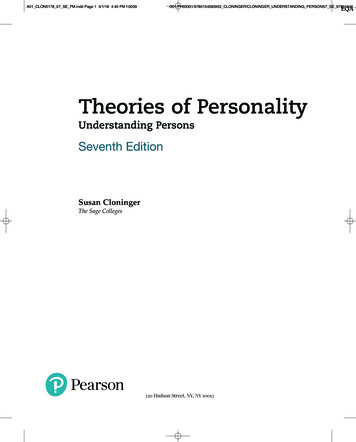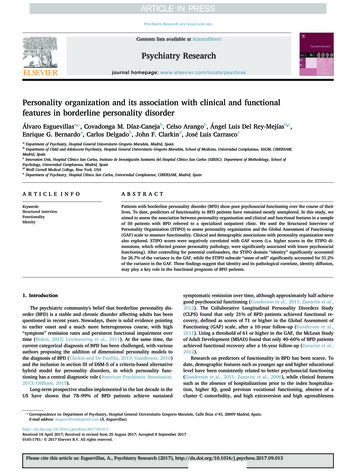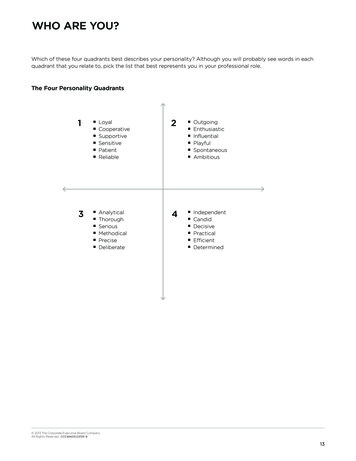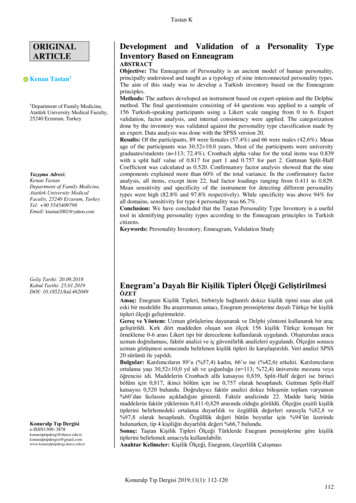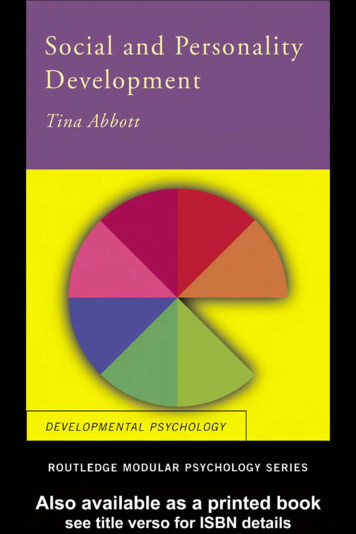
Transcription
Social and Personality DevelopmentSocial and Personality Development looks at the processes by which we come to be whowe are. It covers a range of topics central to personality and developmental psychology.The book is arranged in three sections, the first covering the main theories of personality,the second describing the development of gender and the third focusing on adolescence.It is suitable for the AQA-A A2 Level examination, but will also be of interest to thosestudying education, nursing and other related disciplines.Tina Abbott is an experienced A-level teacher and examiner and is an executive memberof the Association for the Teaching of Psychology.
Routledge Modular PsychologySeries editors: Cara Flanagan is a Reviser for AS and A2 level Psychology and lecturesat Inverness College. Philip Banyard is Associate Senior Lecturer in Psychology atNottingham Trent University and a Chief Examiner for AS and A2 level Psychology.Both are experienced writers.The Routledge Modular Psychology series is a completely new approach tointroductory-level psychology, tailor-made to the new modular style of teaching. Eachshort book covers a topic in more detail than any large textbook can, allowing teacher andstudent to select material exactly to suit any particular course or project.The books have been written especially for those students new to higher-level study,whether at school, college or university. They include specially designed features to helpwith technique, such as a model essay at an average level with an examiner’s commentsto show how extra marks can be gained. The authors are all examiners and teachers at theintroductory level.The Routledge Modular Psychology texts are all user-friendly and accessible andinclude the following features: practice essays with specialist commentary to show how to achieve a higher grade chapter summaries to assist with revision progress and review exercises glossary of key terms summaries of key research further reading to stimulate ongoing study and research cross-referencing to other books in the seriesAlso available in this series (titles listed by syllabus section):ATYPICAL DEVELOPMENT AND ABNORMAL BEHAVIOURPsychopathologyJohn D.Stirling and Jonathan S.E.HellewellTherapeutic Approaches in PsychologySusan CaveClassification and Diagnosis of Abnormal PsychologySusan Cave (forthcoming)BIO-PSYCHOLOGYCortical FunctionsJohn Stirling
The Physiological Basis of Behaviour: Neural and hormonal processesKevin SilberAwareness: Biorhythms, sleep and dreamingEvie BentleyCOGNITIVE PSYCHOLOGYMemory and ForgettingJohn HendersonPerception: Theory, development and organisationPaul Rookes and Jane WillsonAttention and Pattern RecognitionNick LundDEVELOPMENTAL PSYCHOLOGYEarly Socialisation: Sociability and attachmentCara FlanaganPERSPECTIVES AND RESEARCHControversies in PsychologyPhilip BanyardEthical Issues and Guidelines in PsychologyCara Flanagan and Philip Banyard (forthcoming)Introducing Research and Data in Psychology: A guide to methods and analysisAnn SearleTheoretical Approaches in PsychologyMatt JarvisDebates in PsychologyAndy Bell (forthcoming)SOCIAL PSYCHOLOGYSocial InfluencesKevin WrenInterpersonal RelationshipsDiana DwyerSocial CognitionDonald C.Pennington
COMPARATIVE PSYCHOLOGYDeterminants of Animal BehaviourJoAnne Cartwright (forthcoming)Evolutionary Explanations of Human BehaviourJohn Cartwright (forthcoming)Animal CognitionNick Lund (forthcoming)OTHER TITLESSport PsychologyMatt JarvisHealth PsychologyAnthony CurtisPsychology and WorkChristine Hodson (forthcoming)Psychology and EducationSusan Bentham (forthcoming)Psychology and CrimeDavid Putwain and Aidan Sammons (forthcoming)STUDY GUIDEExam Success in AQA(A) PsychologyPaul Humphreys (forthcoming)
To Little Tina and Beans, Love and Peace
Social and PersonalityDevelopmentTina Abbott
First published 2001 by Routledge 27 Church Road, Hove, East Sussex BN3 2FASimultaneously published in the USA and Canada by Taylor and Francis Inc. 29 West 35th Street,New York NY 10001Routledge is an imprint of the Taylor and Francis GroupThis edition published in the Taylor & Francis e-Library, 2005.“ To purchase your own copy of this or any of Taylor & Francis or Routledge’s collection ofthousands of eBooks please go to http://www.ebookstore.tandf.co.uk/.” 2001 Tina AbbottCover design by Terry FoleyAll rights reserved. No part of this book may be reprinted or reproduced or utilised in any form orby any electronic, mechanical, or other means, now known or hereafter invented, includingphotocopying and recording, or in any information storage or retrieval system, without permissionin writing from the publishers.British Library Cataloguing in Publication Data A catalogue record for this book is available fromthe British LibraryLibrary of Congress Cataloging-in-Publication Data Abbott, Tina, 1961– Social and personalitydevelopment/Tina Abbott. p.cm.—(Routledge modular psychology) Includes bibliographicalreferences and index. ISBN 0-415-23103-5 (hbk)—isbn 0-415-23104-3 (pbk.) 1. Personalitydevelopment. 2. Gender identity. 3. Adolescent psychology. I. Title. II. Series BF723. P4 A232001 155.2′5–dc21 2001034799ISBN 0-203-99646-1 Master e-book ISBNISBN 0-415-23103-5 (hbk)ISBN 0-415-23104-3 (pbk)
ContentsList of IllustrationsixAcknowledgementsxi1 IntroductionSection I PERSONALITY DEVELOPMENT2 Two approaches to the study of personality1453 Trait and type theories114 Psychoanalytic theory235 Social learning approaches36Section II GENDER DEVELOPMENT476 Social and biological approaches to gender identity487 Cognitive development theories608 An alternative view of gender identity66Section III ADOLESCENCE9 The concept of adolescence727310 Theories of adolescence8411 Other influences on development9312 Study aids101Glossary115References122Index132
IllustrationsFigures3.1 Diagram illustrating factors and resulting dimension123.2 Eysenck’s initial theory133.3 Costa and McCrae’s NEO-PI five factors184.1Symbolic representation of conscious/ preconscious/unconscious 25mind4.2 Symbolic representation of id/ego/superego275.1 Three factors that interact to create an individual’s personality376.1 Perry and Bussey’s experimental conditions538.1Masculinity/femininity represented on an orthogonal scale andon a continuum679.1Comparison between different cultures of the average age atwhich menarche begins749.2Issues reaching peaks of importance at different ages (Colemanand Hendry 1990)8211.1 Pro-social and anti-social behaviour during adolescence9511.2 Adolescent pregnancy rates per 1000 female adolescents98
Tables2.1 Personality theories categorised as idiographic or nomothetic 93.1Some questions from Eysenck’s Personality Inventory (EPI)146.1The four gender differences supported by Maccoby andJacklin (1974)518.1Percentages of Dimitrovsky et al.’s sample categorised asvarious sex role types688.2 Frable and Bem’s gender/race condition709.175Major hormones involved in physical growth anddevelopment9.2 DSM-IV criteria for bulimia and anorexia nervosa8010.1 Summary of Erickson’s whole life theory plus Freud’spsychosexual stages8912.1110111Mean aggression scores for experimental and control subjects
AcknowledgementsThe series editor and Routledge acknowledge the expert help of Paul Humphreys,Examiner and Reviser for AS and A2 level Psychology, in compiling the Study aidschapter of each book in the series.AQA (AEB) examination questions are reproduced by permission of the Assessmentand Qualifications Alliance. The AQA do not accept responsibility for the answers orexaminer comments in the Study aids chapter of this book or any other in the series.The author would like to thank Adrian for the love, support and guidance he has givenher during the writing of this book. She would also like to thank her sons Josh and Finnfor their patience and understanding, and Warrington for his friendship.
1IntroductionWhy choose to study personality, gender and adolescence?The purpose of this book is to introduce the reader to a variety of traditional andcontemporary psychological theories and studies, which play a key role in informing ourunderstanding of the individual. The three areas covered: personality, gender andadolescence, represent core aspects of individual development. These aspects not onlyplay a profound role in shaping the people we eventually become, but continue to impacton us throughout our lives.The book is divided into three sections: personality development, gender developmentand adolescence.PersonalityThe study of personality has a long history. From the ideas of philosophers such as Galen(second century AD), who believed our personalities are influenced by the presence ofbodily fluids (see Chapter 3), we move to contemporary psychologists, some of whomfocus on internal characteristics, such as traits or instincts, while others see externalfactors in the environment, as important in influencing the ways we behave and thereforeour personalities.The first section of this book focuses on the key approaches to the study ofpersonality, including the ideas of theorists such as Hans Eysenck and Gordon Allport,who see personality as continually influenced by permanent traits, that may or may not beunique to the individual. These theorists have taken a psychometric approach by devisingquestionnaires that can be used to measure personality. Social learning theorists, such asAlbert Bandura and Walter Mischel, who oppose the permanency of personality putforward by psychometric theorists, believe instead that personality is simply a result oflearning in a variety of social situations, and therefore is flexible and changeable. Last inthis section is the psychoanalytic approach (sometimes referred to as the psychodynamicapproach), focusing mainly on its founder, Sigmund Freud, who argued that behaviour,and therefore personality, is driven by dynamic inner forces such as needs, desires andbeliefs. Psychodynamic theorists and social learning theorists share a common belief inthe flexibility of human personality. Their differences however are reflected in thetherapeutic approaches they advocate. Whereas social learning theorists believebehaviour change can best be achieved using behaviourist strategies such as positive ornegative reinforcement (see Chapter 5), psychoanalysts believe more in the power of
Social and personality development2therapeutic interventions that act to unearth repressed memories with the aid oftechniques such as free association (see Chapter 4).Collectively, these approaches to the study of personality provide us with a complexand sometimes contradictory view of the individual, that can raise interesting questionsand debates about the nature of human personality, informing our understanding, andhopefully leading us to greater insight.GenderAs we strive to reach an understanding of the individual through the study of humanpersonality, we cannot fail to realise the crucial role played by gender. Whatever situationwe find ourselves in, whether through work or play, our gender is usually salient. That isto say we are often made aware of our maleness or our femaleness through the optionsavailable to us, and the choices we are sometimes compelled to make. For example, interms of family, work and/or education, gender is often the key aspect that guides ourdecisions. Do we want a family? Or would we like to pursue a career first? Are weprepared to travel with our work? And where do we see ourselves in five years time? Theanswers to these questions are often heavily influenced by our gender.Some people may argue that in contemporary society, gender no longer has the impactthat it traditionally had. Females are no longer expected to stay at home and look after thefamily, while the role of males as main provider is fast changing. Careers are available toboth genders if they wish to pursue them, and carers of children these days are oftenmale. But despite these changes it is easy to see that inequality between the genders stillexists. If a female does decide on a career rather than a family, she may still bestigmatised for her unwillingness to have children. On the other hand, a male whodecides to stay at home and take care of the family may be seen as inadequate in someway. For example, he may be viewed as lacking the characteristics that make a ‘man’,such as the power and ambition to succeed in a career. From a very young age differencesbetween the genders are continually reinforced, from the clothes we wear, the toys we areencouraged to play with, and even the names we are given. Our parents, teachers, peers,the media, books we read, stories we hear, almost every aspect of our social life is gearedtowards this difference. Therefore gender is a constant contributor to the person we are,and the study of gender is essential to our understanding of personality.AdolescenceThe final section of this book focuses on a part of our life that incurs a lot of change andupheaval: adolescence. It is during this time that we begin to question what we want outof life, and to grapple with some major life issues such as identity and sexuality. Forsome teenagers adolescence can be a particularly tough and demanding time. All kinds ofinfluences play a part in aiding the process or making life hard for the young person.Parents, peers and teachers have an influence, often in conflict with social messages fedthrough the media. All can provide support and motivation, or, equally, cause distress anddespair.
Introduction3Throughout this section of the book we focus on the various ways that teenagers reactand interact at home, at school or work, and with friends and family as they strivetowards adulthood. We also look at specific incidences that can occur during this time,such as adolescent pregnancy, eating disorders and suicide. We look at the ways societycan support young people through the agency of social policy, and consider why harmfulincidences such as teenage pregnancies, suicide and eating disorders are on the increasein some Western societies. We discuss both the social and personal factors that may beimpacting on this, and the implications for society as a whole.What questions remain?Of course there are many more questions that remain unanswered and even unasked. Thediversity and complexity of human behaviour will I hope continue to provoke us tosearch for new explanations and insights into the underlying basis of personality. Alongwith the impact of adolescence and gender on the behaviours and personalities ofindividuals, other major life events have as much, if not more of an influence on who weare as people. The arrival of adulthood, promotion at work, a term of imprisonment, thebirth of a child: all of these occurrences can change our outlook on life and so affect ourpersonalities.In writing this book, my aim has been to provide an understanding of some of thefactors that help to shape us into the people we become. I hope it will ignite in the readera curiosity about the causes of human behaviour and the way in which an understandingof this, through the study of psychology, can be used to improve the quality of our lives.Further ReadingEysenck, M.W. (2000) Psychology: A student’s handbook, Hove, UK: Psychology Press. Anexcellent general textbook that provides a good grounding in approaches to the study ofpersonality, as well as interesting ideas on adolescence and gender development.Sampson, E.E. (1991) Social Worlds, Personal Lives: An introduction to Social Psychology, NewYork: Harcourt, Brace, Jovanovich. Provides in-depth coverage of research on personalitydevelopment.
Section IPERSONALITYDEVELOPMENT
2Two approaches to the study of personalityThe study of personalityPersonality is a concept used in everyday life to describe the character of a person. It isoften seen as an unchanging part of their makeup. A commonsense approach to the studyof personality might include the use of everyday language to identify certaincharacteristics. For example an individual might be described as very outgoing and selfconfident, easily able to deal with people and situations. Or they might be described asshy and withdrawn, finding it difficult to interact socially. A person might be admired fortheir wit and charm, or they may be disliked for their coldness and aloofness. These waysof describing people are commonly employed in western cultures.As individuals negotiate their way through life, success often depends on how theyrespond to others, as they participate in the give and take of communication. We oftencategorise ourselves and others as certain personality types, in order to predict whetherthe outcome of a particular social situation is likely to be successful or not. It appears wefind it useful to categorise people in this way, in order to give us a better understanding ofeach other’s behaviour.So how does this way of defining people differ from the way psychologists have triedto understand and study personality?Defining personalityA number of psychologists have attempted to define this hypothetical construct we callpersonality. Having a definition helps to provide a starting point from which to developtheories of personality more fully. These theories can then be usefully applied to real lifesituations, for example in advising parents on positive ways of interacting with theirchildren, in line with their individual personalities, or by constructing more effectiveways of treating specific mental disorders (such as obsessive behaviours).However, because of the diversity of theories that have sprung up in the area ofpersonality, there doesn’t exist one formal definition. The meaning of personality hasbecome tied to the underlying perspective of the theorist. For example constructionistssuch as Hampson (1995) see personality as ‘constructed in the course of social interactionfrom a person’s self presentation, the perception of this presentation by an audience, andself-awareness’. Whereas humanists such as Rogers (1951) see personality as groundedin the way we experience ourselves as people, and which particular characteristics makeus distinctly human.An important difference between various approaches to the study of personality is thatwhile some theorists assume people possess a personality (they were born that way, or
Social and personality development6they are predisposed to behave in a certain way due to their biology or genes), othershave developed the idea that people simply manifest behaviours that are brought about bythe situation they find themselves in. Both approaches may incorporate the language ofpersonality types or personality traits. However, a simple definition that would suit bothapproaches might be: the behaviour a person exhibits at any given time in their lives.The value of studying personalityThe study of personality is linked with many other areas of research within psychology,such as investigations into perception, stereo-typing and the self-concept. For example,the area of perception is concerned with how the individual reacts to the world aroundthem. A very outgoing, sociable individual may perceive the world as an adventurousplace full of interest and intrigue, whereas a shy and retiring individual may perceive theworld as a dangerous and threatening place. The way we perceive the world is thereforein some way shaped by how we perceive ourselves. This self-perception (or self-concept)comes about from a variety of factors, but is often formed by the language either we orothers use to describe us, thereby categorising us as a particular kind of person. The studyof personality, therefore, can be helpful in understanding not only the characteristics ofhuman nature but can also shed light on other psychological phenomena.Idiographic and nomothetic approachesHistorically, research into personality has tended to be split between two approaches: theidiographic approach and the nomothetic approach. This division reflects an importantdifference of opinion in the way psychologists view people as the subject matter. Whenstudied idiographically people are seen as unique individuals, whereas taking anomothetic approach assumes that people are essentially similar and share characteristicswith each other. The difference between these two approaches is discussed in more detailbelow.Idiographic approachesThe idiographic approach (from the Greek ‘idios’ meaning personal or private) takes theview that we are unique individuals and should be studied as such. This means that wecannot rely on descriptions of common behaviours to describe certain types of people,such as people who are shy or people who are aggressive, but should treat each person asuniquely different from any other.So how can this approach be applied to the study of personality? Taking a purelyidiographic approach would require a detailed analysis of an individual’s thoughts,feelings and behaviours, and would not assume that the resulting profile could be appliedto anybody else. The idea of universal features or general behaviours put forward toexplain human behaviour does not belong to, and is not the language of an idiographicapproach.The main advocates of the idiographic approach are from the humanistic school ofthought. This school includes prominent theorists such as Carl Rogers who took a person-
Two approaches to the study of personality7centred approach to therapy, George Kelly who developed the personal construct theory,and Gordon Allport (whose personality theory we will discuss in Chapter 3) whodescribed people as possessing ‘unique personal characteristics’. Sigmund Freud wasanother theorist who took an idiographic approach, by focusing on the individual as themain unit of study. Freud’s personality theory was developed from case studies of hispatients. A final example is Eric Erikson, who put forward a whole life theory ofpsychosocial stages, through which each person must pass during their lifetime. BothFreud and Erikson will be discussed in detail later in the book.To conclude, taking an idiographic approach means researching a theory orphenomena by studying people individually and recognising their uniqueness, withouttrying to categorise them.Nomothetic approachesThe nomothetic approach (from the Greek ‘nomos’ meaning law) relies on theassumption that we share many characteristics with our fellow human beings, and that thestudy of behaviours we hold in common will lead to a more useful understanding ofpeople. It is typically characterised by the use of experimental methods, such asmeasuring individuals on a scale, or carrying out controlled studies where variables canbe isolated, in order to uncover universal laws that can be applied to everyone. Taking anomothetic approach involves categorising people in order to describe or uncover thecauses of common behaviours, such as sociability or generosity.This approach has been employed by cognitive psychologists such as Raymond Cattelland Hans Eysenck, both of whom believe that the basic core of human personality ismade up of a number of traits or dimensions. As a well-known example, Eysenck putforward introversion/extroversion as a universal personality dimension that can beemployed to describe and measure part of any individual’s personality in varyingdegrees. (Eysenck’s theory will be discussed fully in Chapter 3.)Progress exerciseBefore reading any further see if in your own words you can explain the differencebetween idiographic and nomothetic approaches to the study of personality.Advantages and disadvantagesThe debate over the use of the two approaches has developed because each approach hasboth strengths and weaknesses associated with it.A key strength of the nomothetic approach is that its methodologies are in line withother sciences such as chemistry or physics. These sciences are largely built around thediscovery of universal laws which can be used to explain natural phenomena. However,in terms of psychological research, the possibility of uncovering and applying universal‘laws’ to people in order to predict their behaviour has a number of problems associatedwith it. The outcome of such research could lead to unethical consequences if it wereused to control and shape people’s lives. Historically this has occurred in the use of testswhich claimed to measure a universal construct known as intelligence (see Gould 1981),
Social and personality development8which sadly led to the oppression of minority groups on the basis of their low scores inthese tests. A further problem with nomothetic research findings is that they may provideonly a superficial understanding of an individual, a particularly worrying weakness interms of the use of these findings in diagnosing mental disorders. Nevertheless,uncovering universal behaviour patterns for some psychological disorders (such as thoseexhibited in autism) can provide us with crucial information that may help in constructingpositive and effective treatments.Idiographic studies uncover individual differences and allow us to develop detailedanalyses of the individual person. This is where the idiographic approach has a realadvantage over the nomothetic approach, as it means that we can tailor diagnosis andtreatment much more specifically to meet the needs of the individual. We can also gain agreater insight into an individual’s strengths and weaknesses, and so guide them moreeffectively.Idiographic research has often been the catalyst that has encouraged furthernomothetic investigation into specific areas of interest. One example of this is the workcarried out by Jean Piaget on the cognitive development of children. Piaget took anidiographic approach by observing and interviewing individual children over a period oftime. From this he developed his influential theory of cognitive development, whichsparked off a multitude of nomothetic experimental studies. Another example is the workof Freud, where again his approach was essentially idiographic (i.e. case studies) but ledto nomothetic conclusions, such as his suggestion of the existence of universal defencemechanisms (although this theory is difficult to prove empirically). This leads us to themain disadvantage of an idiographic approach: the generation of empirical evidence fromindividual cases means that we cannot legitimately generalise idiographic findings to allpeople. The findings are by themselves unreliable because they are based on thesubjective experiences or behaviours of a limited number of individuals, and may beinvalid if we try to apply them to our understanding of people as a whole.Nomothetic versus idiographicIs the distinction between idiographic and nomothetic approaches really valid? Holt(1967) argues that the whole issue is built on a false dichotomy. To say that an individualshould only be studied in terms of what makes him unique, with no reference to universalbehaviours (or even other individuals), is an impossibility. As pointed out by Radford andKirby (1975) ‘a truly unique individual would be incomprehensible, in fact notrecognizable as an individual’.However the dichotomy does still stand and has some use, not only in facilitating adiscussion between various approaches, but also in ensuring that we continually questionwhat it is to be a person.ConclusionBoth the idiographic and nomothetic approaches to the study of personality can bebeneficial to our understanding of people. Each approach has its own strengths and its
Two approaches to the study of personality9own weaknesses. The view put forward by Kluckhohn and Murray (1953) on theunderstanding of people is relevant here. They note that every person is like no other,Table 2.1 Personality theories categorised asidiographic or nomotheticBehaviour seen as due topersonality traits, where change isunlikelyBehaviour seen as due to environmentalfactors, where change is possibleNomothetic Eysenck’s type theoryPsychoanalytic theoriesIdiographic Allport’s trait theoryHumanistic theoriesAdapted from Gross (1990) by permission of Hodder and StoughtonEducational Limited.like some other and like all other people. In other words there are similarities and somedifferences between people within cultures, and between cultures. But also there are someuniversal characteristics that supersede culture and individual differences. It seems thatwe must draw on both approaches if we are to achieve a more complete understanding ofpeople.Review exerciseDraw up a table to show the main advantdges and disadvantages of the idiographic andnomothetic approaches to the study of personality, Use examples of research to illustrateyour points.SummaryPersonality is an important everyday concept, helping us to understand the behaviour ofothers. Research into personality has tended to be split between two approaches: theidiographic approach and the nomothetic approach. The idiographic approach involvesstudying people as unique individuals. Idiographic studies are well suited to situationswhere a deep understanding of the individual person is required.They have also often been the catalyst that has encouraged further nomotheticinvestigation into specific areas of interest. However, we cannot automatically generaliseidiographic findings to all people because they are based on studies of a limited numberof individuals. Nomothetic research involves the study of the behaviour of manyindividuals, typically relying on statistical tests to uncover trends and differences. Thenomothetic approach thus complements the idiographic approach and is helpful in studiesaimed at firmly establishing universal laws of behaviour. As useful as they are,nomothetic research findings may on their own provide an oversimplified picture ofbehaviour which is not always useful in practical applications.
Social and personality development10Further readingGross, R.D. (1999) Psychology: The Science of Mind and Behaviour (third edition), London:Hodder and Stoughton. A
Social and Personality Development Social and Personality Development looks at the processes by which we come to be who we are. It covers a range of topics central to personality and developmental psychology. The book is arranged in three sections, the first covering the main theories of personality, the second describing the development of .

